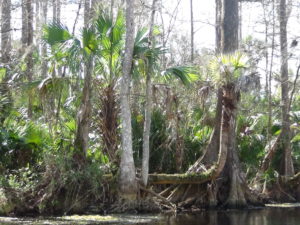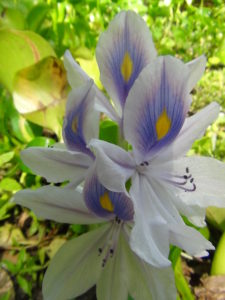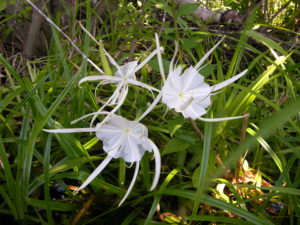We offer 3 guided canoe and kayak trips on the Ocklawaha River:
- Ocklawaha River: Gore’s Landing – Eureka (see description below)
- Ocklawaha River: Silver River – Gore’s Landing
- Florida’s Pompeii – The Reservoir (Rodman Dam)
 Ocklawaha River: Gore’s Landing – Eureka Canoe and Kayak trip
Ocklawaha River: Gore’s Landing – Eureka Canoe and Kayak trip
Group size: 1 – 24 people.
Trip length : 4 – 4.5 hrs.
Skill level: Great for beginners and experts alike.
Difficulty: This is easy flowing water with few (if any) obstacles. And it’s all downstream. Novices will not have a problem. The main consideration is your endurance. For some, 3 – 4 hours of paddling can be tiring. But, it’s all downstream and, as many of you know, we encourage paddlers to take their time to enjoy the surroundings.
Cost
Most guided tours are $50 per person. (includes boat, paddle, vest, shuttling and your guide)
Using your Own Boat – $40. (many paddlers with their own boats like to join us to learn more about the history, archaeology and natural history of these rivers).
Dates
Join a scheduled tour (see tour calendar ), or suggest one. Find a free date on the calendar and suggest the trip of your choice. If there are no conflicts, we’ll post it!
OR
Schedule a private tour. Use contact form, email us at riverguide2000@yahoo.com or call (386-454-0611)
Location
Check the River Locator Map or Click the link below for a local map and then use zoom and panning arrows to explore the area. (Note: the marker is NOT our meeting place, but a nearby landmark.
Local MapDescription
This is the Ocklawaha which Florida’s noted author, Marjorie Kinnan Rawlings, knew and loved. And it’s the Ocklawaha to which a couple of Florida’s most celebrated musical troubadours, the late, great Will Mclean and Don Grooms, retreated when the press of civilization became unbearable.
 The scenery for most of this trip is dominated by a wonderful panorama of river forests and swamps, with the usual menagerie of wildlife that love such places. Occasionally, as with the adjoining stretch of the river described above, the river carries us close to the high piney bluff which borders the river basin for many miles to the north and south of here. This steep bluff, formed by uplift fault activity and earthquakes millions of years ago, marks the western edge of Florida’s famous sand pine forest – the ‘scrub.’
The scenery for most of this trip is dominated by a wonderful panorama of river forests and swamps, with the usual menagerie of wildlife that love such places. Occasionally, as with the adjoining stretch of the river described above, the river carries us close to the high piney bluff which borders the river basin for many miles to the north and south of here. This steep bluff, formed by uplift fault activity and earthquakes millions of years ago, marks the western edge of Florida’s famous sand pine forest – the ‘scrub.’
This trip has a lot to offer to people with a variety of interests. As history buffs dream of Acuera warriors and steamboats which once once plied these waters, birders and animal lovers will be getting a lot of use out of their binoculars and cameras. And if you, like myself, are fans of Marjorie Rawlings, this trip will give you a chance to explore a remote section of Florida that remains much as it did when she stayed nearby at the Fiddia homestead, researching her book, The Yearling.
 Wildlife
Wildlife
The abundance and diversity of birds in a habitat reflect the complexity of that habitat – and the Ocklawaha swamp is one of the most complex habitats in the state. Throughout the summer, red-shouldered hawks and barred owls are occasionally seen gliding through the canopy in search of rodents, reptiles and, sometimes other, smaller birds. The songsters of the swamp are the warblers. Swainson’s, hooded and parula common summer residents, while in the winter, you are more likely to hear (and see) the beautiful little yellow and grey, prothonotary warbler.
– Forager’s Notebook –
 Water Hyacinth
(Eichhornia crassipes)
Water Hyacinth
(Eichhornia crassipes)
This exotic plant, an unwelcome import from South America, has edible leaves, roots and flowers. But be sure to boil or steam them first, as the raw plant parts burn like hell in the mouth. Leaves are a fair source of vitamins A, B1 and B2. They contain 18.7% protein, 17.1% fiber and 36.6% carbohydrates. The roots are 11% protein, 7.9% fiber and 41.6% carbohydrates. But all nutritional values aside, I think the best tasting part is the crisp, tender stolons which connect the plants at the roots. Each year, the state of Florida spends nearly $15 million to control this plant. Some of this is by spraying poisons, so be very careful where you gather hyacinths.
History
After the annihilation of the Timucuas, Creek migrants (soon to be called Seminoles) moved in to the Ocklawaha country. Some of the bigger villages were those of Black Dirt (located near the confluence of Eaton Creek) and Coe Hadjo (to the north of Eureka). One of the first treaties made between the Seminoles and American settlers was signed at a well-known gathering spot along the river known as Paynes Landing.
 After the Seminoles were driven south into the Everglades or deported to the west, the river was opened up to commerce. It took over a year for the river to be cleared of downfallen trees before steamboats could make the journey up. Even then, the narrowness of the stream and overhanging trees required some modifications to be made to the traditional steamboat design. The odd, little Ocklawaha steamers, which Sidney Lanier described as looking somewhat like a “Pensacola gopher” (a tortoise), made their way.
After the Seminoles were driven south into the Everglades or deported to the west, the river was opened up to commerce. It took over a year for the river to be cleared of downfallen trees before steamboats could make the journey up. Even then, the narrowness of the stream and overhanging trees required some modifications to be made to the traditional steamboat design. The odd, little Ocklawaha steamers, which Sidney Lanier described as looking somewhat like a “Pensacola gopher” (a tortoise), made their way.
